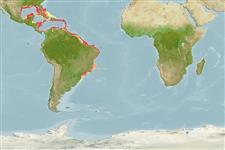Environment: milieu / climate zone / depth range / distribution range
Ecología
marino asociado a arrecife; rango de profundidad 36 - 118 m. Tropical; 30°N - 33°S
Western Atlantic: Florida and northern Gulf of Mexico in USA to Brazil.
Tamaño / Peso / Age
Maturity: Lm ? range ? - ? cm
Max length : 23.0 cm TL macho / no sexado; (Ref. 7251)
Espinas dorsales (total) : 11 - 12; Radios blandos dorsales (total) : 9; Espinas anales: 3; Radios blandos anales: 5. Occipital pit present; adults with three to four spines on part of preorbital overlapping maxillary; supplemental preopercular spine present; no dark spots on inner basal part of pectoral fin; generally pale in color with some dark pigments (Ref. 13608).
Inhabits offshore waters.
Life cycle and mating behavior
Maturities | Reproducción | Spawnings | Egg(s) | Fecundities | Larva
Robins, C.R. and G.C. Ray, 1986. A field guide to Atlantic coast fishes of North America. Houghton Mifflin Company, Boston, U.S.A. 354 p. (Ref. 7251)
IUCN Red List Status (Ref. 130435)
Threat to humans
Harmless
Human uses
Herramientas
Special reports
Download XML
Fuentes de Internet
Estimates based on models
Preferred temperature (Ref.
123201): 19.5 - 27.2, mean 24.5 °C (based on 115 cells).
Phylogenetic diversity index (Ref.
82804): PD
50 = 0.5000 [Uniqueness, from 0.5 = low to 2.0 = high].
Bayesian length-weight: a=0.01318 (0.00626 - 0.02776), b=3.03 (2.86 - 3.20), in cm total length, based on LWR estimates for this Genus-body shape (Ref.
93245).
Nivel trófico (Ref.
69278): 3.7 ±0.2 se; based on size and trophs of closest relatives
Resiliencia (Ref.
120179): Medio, población duplicada en un tiempo mínimo de 1.4-4.4 años (Preliminary K or Fecundity.).
Fishing Vulnerability (Ref.
59153): Low vulnerability (13 of 100).
Nutrients (Ref.
124155): Calcium = 58.9 [29.5, 131.7] mg/100g; Iron = 0.599 [0.321, 1.621] mg/100g; Protein = 18.6 [16.9, 20.2] %; Omega3 = 0.238 [0.107, 0.634] g/100g; Selenium = 33.7 [17.9, 81.3] μg/100g; VitaminA = 136 [47, 370] μg/100g; Zinc = 1.31 [0.91, 1.87] mg/100g (wet weight);
